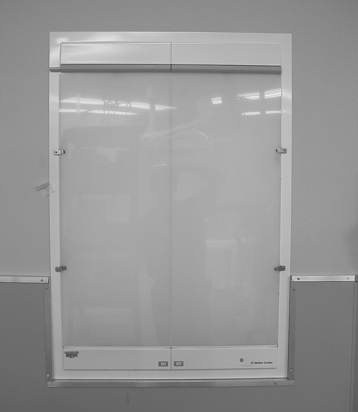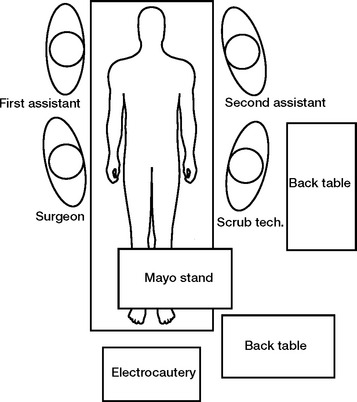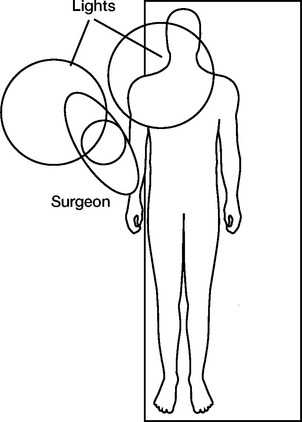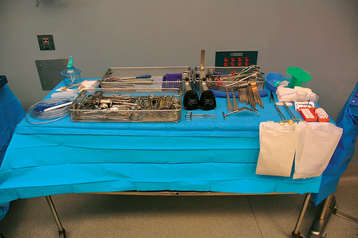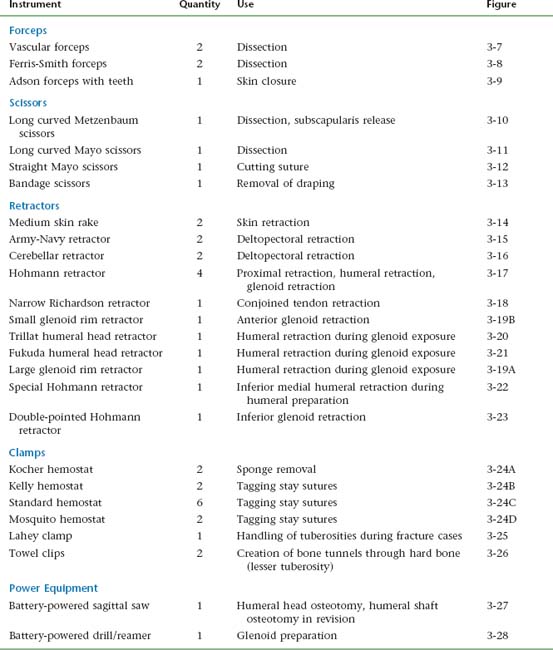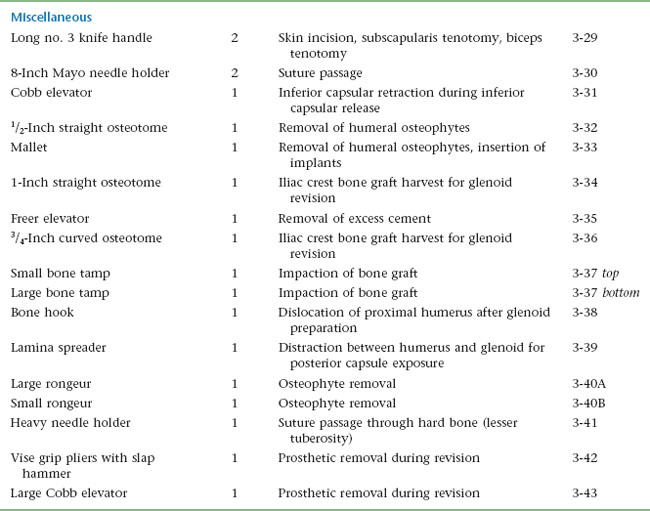CHAPTER 3 Operating Room Setup
This chapter outlines the organization of the operating room used for shoulder arthroplasty. Organization of the arthroplasty surgical suite focuses on the cor-rect position of equipment, staff, and lights. In addition, all necessary surgical instrumentation must be available.
OPERATING ROOM LAYOUT
A large operating room is preferable when performing shoulder arthroplasty. Larger operating rooms allow a complete set of implants to be stored in the room on a mobile shelving unit to minimize traffic in and out of the operating suite. Our operating suite has two doors: one main door from the hall through which the patient is transported and a second door going into the substerile area. After the patient is placed on the operating table, the main door is locked to further minimize traffic. A view box is used to display radiographs and secondary imaging studies during the procedure so that they can be referenced quickly if necessary (Fig. 3-1).
An overview of the operating room layout is shown in Figure 3-2. The operating table is placed directly under the operating lights and is not angled within the room. Anesthesia equipment is located at the head of the operating table. The electrocautery unit and power source (saw/drill/reamer) are placed on a mobile cart at the foot of the operating table. A Mayo stand is positioned over the patient’s lower extremities and comes in from the nonoperative side. Two back tables of equipment are placed on the nonoperative side. The cord for the electrocautery handpiece and the tubing for suction are passed off the foot of the operating table. Mobile shelving units containing a full set of implants are placed against a wall of the operating room.
STAFF POSITIONING
Figure 3-2 shows the location of each member of the operative team. The operating surgeon stands facing the patient’s axilla. The first assistant stands just behind the operative shoulder, facing the surgeon. If available, a second assistant stands on the opposite side of the operating table from the surgeon. The position of the second assistant serves dual purposes: first, it allows the assistant to perform retraction without “crowding” the surgeon, and second, if any observers are present, this allows them to have an unhindered view of the procedure. The surgical technician stands on the nonoperative side of the patient between the back tables and the operating table. If needed in the absence of a second assistant, the surgical technician can use one hand to hold a retractor during selected portions of the procedure.
OVERHEAD LIGHTING
Lighting is critical when performing shoulder arthroplasty. Although some surgeons use accessory lighting (i.e., headlamps) for open shoulder surgery, we have found that proper positioning of the overhead lights precludes the need for such devices. Figure 3-3 demonstrates proper light positioning during shoulder arthroplasty performed by a right hand–dominant surgeon. The main operating room light is positioned just above the surgeon’s left shoulder to prevent the surgeon’s operating hand from interfering with the light path. The secondary light is positioned on the surgeon’s right side more cephalic than the main light. These relationships are reversed for a left hand–dominant surgeon.
SURGICAL INSTRUMENTATION
Figure 3-4 shows the arrangement of instruments placed on the Mayo stand during shoulder arthroplasty. Figures 3-5 and 3-6 show the arrangement of instruments on the back tables. Table 3-1 lists all instruments in our shoulder arthroplasty set along with their use during the procedure. Table 3-2 lists the sutures and disposable instruments that we have available during shoulder arthroplasty. Table 3-3 lists the specific product sets that we use during shoulder arthroplasty.

